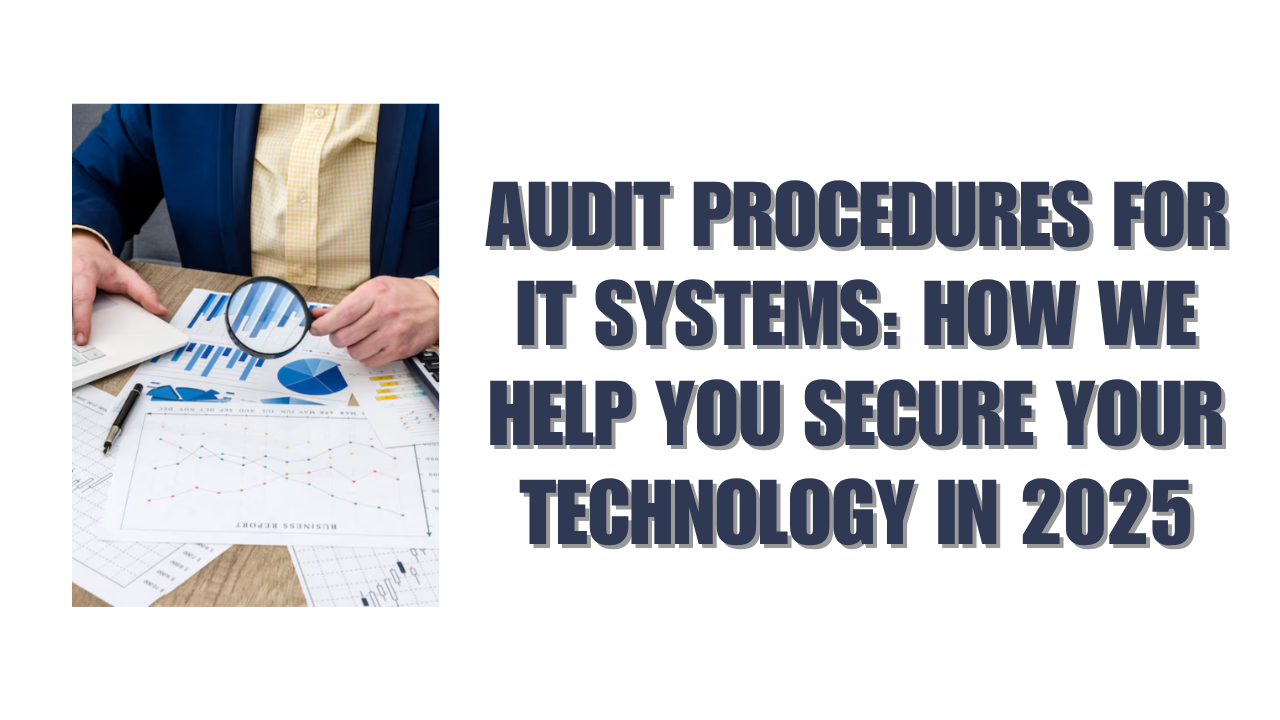In today’s fast-paced digital world, almost every business depends heavily on IT systems. From managing financial data and customer relationships to facilitating daily operations, your technology is the backbone of your organization. But with this reliance comes significant risks. Systems can fail, data can be compromised, and cyber threats continue to grow in complexity. It’s no longer enough to hope your IT environment is secure – it must be verified regularly through effective audit procedures for IT systems.
At Aurora Financials, we’ve worked with businesses across various industries, seeing firsthand how a solid IT audit can make a difference. It’s not just about compliance or ticking boxes; it’s about truly understanding your IT systems, identifying risks, and helping you build a stronger foundation. This article will take you through the essential audit procedures for IT systems, explaining why they matter and how they protect your business.
What Is an IT Systems Audit?
When you think about audits, financial statements probably come to mind first. But an IT systems audit focuses specifically on the technology and controls that support your business processes. It’s like a comprehensive check-up for your IT infrastructure.
The audit examines everything from access controls and software applications to data integrity and disaster recovery plans. The goal is to ensure that your systems are secure, reliable, and that the information they produce is accurate and trustworthy.
IT audits also play a crucial role in validating your financial reporting since so much of your financial data depends on IT systems. Errors or weaknesses in IT controls can lead to inaccurate reports, exposing your business to financial risks or regulatory penalties.
Why Auditing IT Systems Is More Important Than Ever
There are several reasons why audit procedures for IT systems have become essential for every business:
- Rising Cybersecurity Threats: Cyber-attacks are not only increasing in number but also becoming more sophisticated. A breach can disrupt your operations, damage your reputation, and result in costly legal consequences.
- Regulatory Compliance: New regulations require businesses to demonstrate effective IT controls. Whether it’s data privacy laws or financial reporting standards, auditing IT systems helps ensure compliance and avoid penalties.
- Business Continuity: Unexpected IT failures can halt your business operations. Auditing your backup and recovery procedures ensures you can quickly restore services when disasters strike.
- Stakeholder Confidence: Investors, partners, and customers expect transparency and reliability. Showing that you regularly audit and strengthen your IT systems builds trust.
Having partnered with many clients on their IT audit journeys, we’ve seen how a proactive approach can prevent issues before they escalate and help organizations respond quickly when incidents occur.
Step 1: Planning and Understanding Your IT Environment
A successful IT audit starts long before the first test. We begin by gathering as much information as possible about your IT environment. This means learning about the hardware, software, networks, and key business processes your systems support.
During this phase, we review previous audits, risk assessments, and any recent incidents. We meet with your IT staff and business leaders to understand their concerns and priorities. The goal is to identify which areas carry the most risk and deserve the most attention.
A well-planned audit ensures time and resources focus on what matters most to your business. It also helps us tailor the audit procedures for IT systems to your specific context rather than applying a generic checklist.
Step 2: Testing IT General Controls (ITGC)
IT General Controls, or ITGC, are the foundational controls that keep your entire IT environment secure and functioning properly. These include:
- Access Controls: Who can access your systems? We review user accounts, permissions, and how access is granted and revoked. Ensuring only authorized personnel can enter your systems helps prevent insider threats and unauthorized changes.
- Change Management: Systems need updates and patches, but these must be controlled. We check if changes to software and infrastructure follow a formal approval process, including testing and documentation. This reduces risks from untested or malicious changes.
- Backup and Recovery: Regular backups are your safety net in case of data loss. We examine backup schedules, storage methods, and whether backups are tested to ensure data can be recovered when needed.
- Physical Security: Protecting hardware and data centers is just as important as digital security. We assess physical safeguards like locks, surveillance, and environmental controls.
Testing ITGC involves reviewing policies, logs, reports, and often interviewing key staff. Strong ITGC means the building blocks of your IT environment are secure, giving confidence that systems operate as intended.
Step 3: Auditing Application Controls
Beyond general controls, specific applications like accounting software, customer relationship management (CRM) systems, or inventory management tools have their own controls. These application controls ensure that transactions are authorized, processed correctly, and recorded accurately.
Examples of application controls include:
- Input Validation: Ensuring data entered into a system is complete and accurate.
- Approval Workflows: Requiring managerial approval for critical transactions.
- Reconciliations: Matching system data to external records or documents.
- Audit Trails: Tracking user actions to detect errors or fraud.
During this step, we test samples of transactions, review system reports, and observe application processes. The goal is to confirm these controls effectively prevent or detect errors and irregularities.
Step 4: Assessing IT Security Measures
Security is a critical focus of any IT audit. We assess whether your security tools and processes are sufficient to protect against cyber threats.
This includes evaluating:
- Firewalls and Network Security: Are boundaries between your internal network and the internet protected? Are suspicious activities monitored?
- Antivirus and Malware Protection: Are systems equipped and updated to detect malicious software?
- Encryption: Is sensitive data encrypted in storage and transit?
- User Awareness and Training: Are employees educated about cybersecurity best practices and phishing risks?
We may recommend additional testing such as vulnerability scans or penetration tests to identify hidden weaknesses. These proactive measures help you stay one step ahead of attackers.
Step 5: Governance and Risk Management of IT
Effective IT risk management requires more than technical controls. Governance frameworks and organizational culture play a huge role.
We look for evidence that:
- IT policies and procedures are documented and regularly updated.
- Roles and responsibilities for IT risk management are clearly assigned.
- Risks are regularly identified, assessed, and addressed.
- Reporting mechanisms keep leadership informed about IT risks and incidents.
Strong governance ensures IT risks are managed strategically, not just reactively. This approach supports better decision-making and resource allocation.
Step 6: Validating Data Integrity
Data is the lifeblood of any organization. If your data isn’t accurate or complete, business decisions and financial reports can be seriously compromised.
To validate data integrity, we:
- Compare data in IT systems with source documents.
- Track data flows between systems to ensure consistency.
- Check for unauthorized or unexplained data changes.
- Evaluate controls over data entry and maintenance.
This detailed testing confirms that the information your systems produce can be trusted.
Step 7: Reporting and Recommendations
The final stage of the audit is delivering clear, practical findings. We don’t just hand over a technical report filled with jargon. Instead, we focus on what matters to your business:
- What’s working well?
- Where are the weaknesses or risks?
- What actions should be taken first?
- How can controls be strengthened efficiently?
We believe audit reports should empower your team to take action confidently. And because we’ve supported many organizations through these improvements, we understand the challenges you might face — helping you overcome them is part of our ongoing support.
How Aurora Financials Supports Your IT Audit Journey
While many firms offer audit services, what sets a trusted partner apart is experience and collaboration. We bring years of expertise working with diverse clients, understanding that each business has unique IT challenges.
Our approach is not just to find problems but to help you understand and solve them. We work closely with your team, offering insights and practical advice, making the audit process smoother and more valuable.
By choosing the right audit partner, you gain more than just a report — you gain a trusted advisor focused on helping your business succeed safely and sustainably.
Conclusion
IT systems are essential for today’s business operations, but they also bring risks that must be carefully managed. Through thorough audit procedures for IT systems – from general controls to security and governance – businesses can protect themselves against threats, comply with regulations, and build stakeholder confidence.
By adopting a clear, tailored approach to IT audits, organizations position themselves to respond quickly to issues and maintain smooth operations.
If you want to strengthen your IT controls and reduce risks, partnering with experienced professionals who understand your business and technology is key. Together, we can help you secure your IT environment and build a solid foundation for future growth.
FAQs
1. Why is auditing IT systems crucial for business success?
Auditing IT systems helps identify weaknesses before they lead to bigger problems. It ensures security, accuracy, and compliance – all essential for protecting your assets and reputation. Regular audits keep your business resilient in a rapidly changing digital world.
2. How can IT audits improve financial reporting?
Since financial data often flows through IT systems, strong IT controls help ensure that financial reports are accurate and reliable. IT audits detect errors or vulnerabilities that might affect your financial statements, reducing the risk of misstatements or fraud.
3. What makes a good IT audit partner?
A good partner combines technical knowledge with business understanding. They communicate clearly, tailor audits to your needs, and support you beyond the report. Experience working with businesses like yours means they know how to turn audit findings into practical improvements.
If you’d like, we can discuss how these audit procedures for IT systems apply specifically to your business or answer any questions about IT risks. Just reach out when you’re ready.






